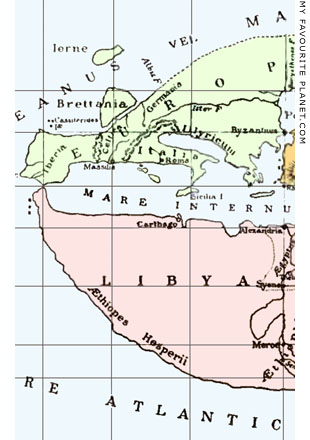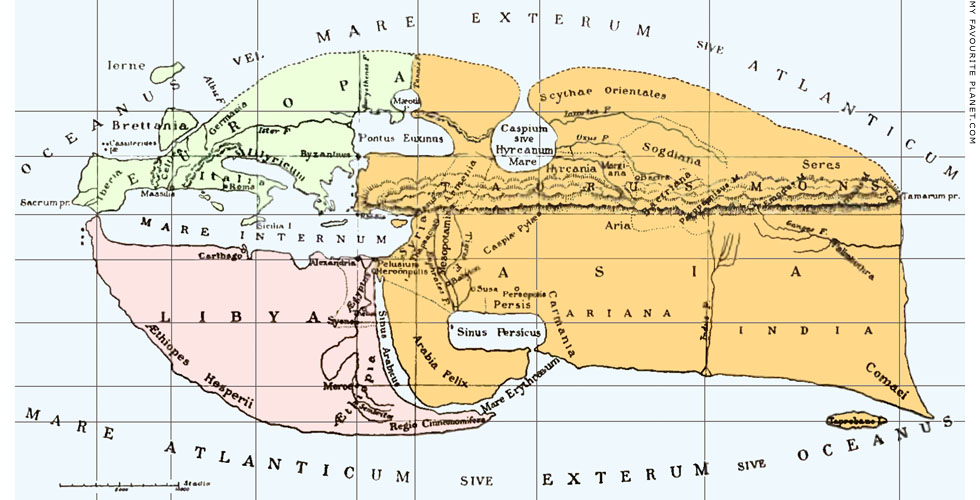1. Editions and manuscripts of Strabo's Geography
The first of three volumes of the first English translation of Geography was published in 1854. Hans Claude Hamilton (1811-1895) translated the first six books, and William Falconer (1801-1885) completed the project by translating the remainder of the books.
"The present translation of Strabo, the great Geographer of Antiquity, is the first which has been laid before the English public. It is curious that a classic of so much renown and intrinsic value should have remained a comparatively sealed book to this country for so many centuries; yet such is the fact. It is true that the imperfect state of the Greek text, and the difficulty of geographical identification, have always been appalling obstacles; yet, after the acute and valuable labours of Gossellin, Du Theil, Groskurd, and especially of Gustav Cramer of Berlin, (whose text is followed in the present volume), we might fairly have expected that some English scholar would have ventured to enter the field. But the task, like many in a similar position, has been reserved for the publisher of the Classical Library, and he trusts it will be found conscientiously fulfilled."
Foreword to Volume I.
Falconer's uncle, Thomas Falconer (1738–1792) had prepared materials on Strabo which he gave to William's father Thomas Falconer (1772–1839) who edited Strabonis Rerum Geographicarum Libri XVII, Graece et Latine... (Clarendon Press, Oxford, 1807), in Greek and Latin in parallel columns. The father also passed on to his son the manuscript of an English translation on which he had been working.
The preface of Volume III, published in 1857, includes a biography of Strabo, based on what had been gleaned of his life up to that date, and a summary of various Medieval manuscripts and fragments, as well as translations into modern languages (Italian, French, German).
Hans Claude Hamilton and William Falconer, The Geography of Strabo, Volume 1 (of 3). A literal translation, with notes. Henry H. Bohn, London, 1854. At Hathi Trust Digital Library.
Volume II, 1856.
Volume III, 1857, with a complete index.
Modern readers may prefer the Loeb edition, with the English and Greek on opposite pages, a lengthy introduction, bibliography and index:
Horace Leonard Jones (translator), The Geography of Strabo, Volume I (of 8). Loeb Classical Library. William Heinemann, London; G. P. Putman's Sons, New York. 1917. At the Internet Archive, with links to other volumes and editions.
2. Strabo's Historika hypomnemata
Scholars have recently speculated that the work may have covered the period from the time of Alexander the Great until 27 BC, the beginning of the reign of Emperor Augustus, or a decade later.
The Greek word hypomnemata (υπομνήματα) means notes, much as the word is used today for lists and other information written as an aid to memory, memoranda and comments added to official and unofficial records. It was translated into Latin as commentarii, and historiographical works of hypomnemata and commentarii comprised a sub-genre. The word has been translated into English as commentaries, sketches and memoirs (this now usually used for autobiographical works).
The Jewish historian Flavius Josephus (37 - circa 100 AD) is known to have quoted passages from Strabo's Historica hypomnemata in his Antiquities of the Jews. Strabo himself refers to it in the Geography:
"We have enlarged on the subject of the Parthian customs in the sixth book of Historical commentaries, and in the second of those, which are a sequel to Polybius: we shall omit what we said, in order to avoid repetition; adding this only, that Poseidonius affirms that the council of the Parthians is composed of two classes, one of relatives, (of the royal family), and another of wise men and magi, by both of which kings are chosen."
Strabo, Geography, Book 11, chapter 9, section 3. Translated by H. C. Hamilton and W. Falconer. George Bell & Sons, London, 1903. At Perseus Digital Library.
See: Hugh Lindsay, Strabo and the shape of his Historika Hypomnemata, The Ancient History Bulletin, Volume 28 (2014) Numbers 1-2, pages 1-19. |
|











